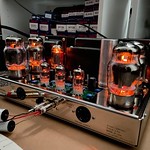 by Wharfcreek Sat Jul 03, 2021 9:53 am
by Wharfcreek Sat Jul 03, 2021 9:53 am
First, this is a highly debatable subject. From a purly 'electronic' standpoint, the process of 'rectification' is essentially the same, whether done via a solid state device or a vacuum tube. However, it's really not quite that simple!! There are 'characteristics' of both that can come into play in the audio world. When dealing with solid state rectification, you have a minimal 'voltage drop' as associated with the rectification process. However, as most any solid state device is a 'switching device', this introduced some noise issues with some of the early solid state rectifiers. This noise was limited by better designs in power supplies, as well as the introduction of better devices. In today's world, the problem is minimal, but it can still raise it's ugly head from time to time. As to 'tube' rectification, the problem of 'switching noise' was virtually non-existant. BUT, you have 2 other things that have to be addressed: The first is the obvious need for a secondary filament source for the rectifier itself, and the second is the amount of voltage drop associated with the tube being used. In both cases it is the job of the product designer to address these issues and construct a proper design that results in properly functioning product. Once that product is in the owner's hands, you now get into that area of 'What if I change things myself?' This is where you simply have to know what you're doing.....or risk the consequences.
To directly answer your question, the simple fact is that if you use a solid state device as a replacement for a 'tube' rectifier, you'll likely encounter a change in voltage supply to the amp. This change in voltage can often result in a change in sonic signature. This 'change' is not the same in all amps........so to attempt to describe it is really somewhat futile. BUT, this is really no different than what one might experience if, for instance, you had an amp that was designed to use a 5U4 rectifier, and you decided to replace that with a 5AR4 rectifier. The difference here is roughly 40 volts INCREASE within the power supply. If you changed a 5U4 to a solid state rectifier, it would increase even more. And, this 'increase' in voltage would likely result in a change in the characteristics of your amp. This, in turn, might be simply boiled down to 'accuracy'! If the original design of the amp in using the 5U4 produced the most accurate frequency response, then the increase in voltage would likely alter things such that an 'inaccuracy' could now be measured at some points within it's audio frequency response. To some, this might sound better!! To others.....not so much. But, were you to swap out a 5U4 with a solid state rectifier circuit that would emulate the 5U4 voltage response, then you might end up having very little if any detrimental affect on the amps distortion levels.
In the hi fi world, this is pretty critical stuff...as 'accuracy' is really the primary target. In the musical instrument amplifier world, it's a different story. There the swap from a 5U4 rectifier to a 5AR4 or a solid-state 'plug' type rectifier can affect the amp in a very favorable way......if you're the musician! Of course, the amp's power supply filter section may ultimately fail and need to be replaced and updated...... as the increase in voltage may simply be too much for old filter capacitors. But, that's what happens in the guitar amp world!! In the Hi Fi world, the need for all the considerations is a bit different, as the 'results' of this kind of a change is NOT always in the best interest of reproducing music accurately. But, if proper attention is paid to all the variables associated with making the change, then at the very least, the system will likely benefit by the reduction in demand from the power transformer to light up the rectifier. Beyond that, if the desing calls for 400 volts, and that's what you get with your Tube rectifier, and if you change to solid state and 'adjust' to maintain 400 volts (which is the proper thing to do)..... then as long as the rest of the amp's power supply is doing what it should to support the current demands, you should experience virtually no difference in the sonic performance from an 'audible' perspective......or so I believe to be true. Likewise, if you go with a Tube Rectifier FROM a Solid State rectifier, again, as long as both the voltage and current requrements of the amp are met by the divices chosen, then all you're really doing is (as stated above) adding another tube to look at, and another filament to power up, and you'll likely hear no difference at all. Just my opinion, but I'm stickin' to it!!
Tom D.
Last edited by Wharfcreek on Sat Jul 03, 2021 9:57 am; edited 1 time in total (Reason for editing : Added a closing comment.)



